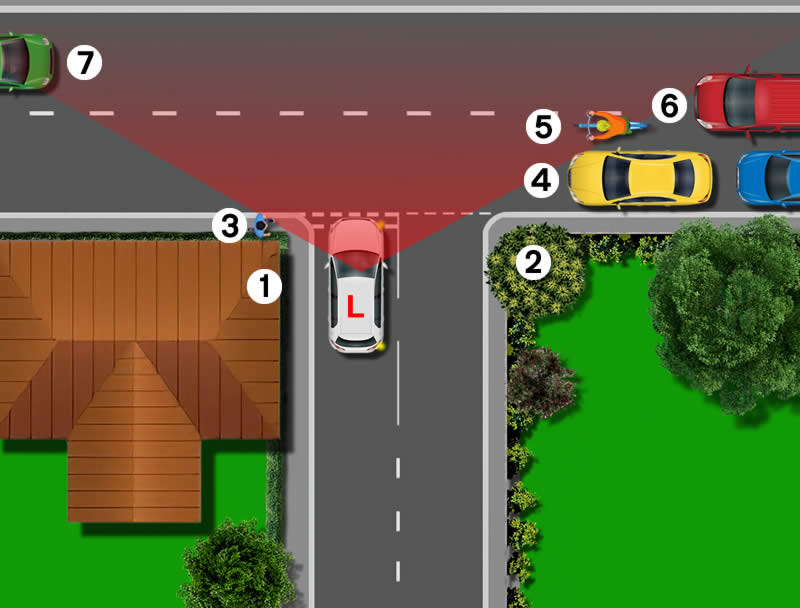Blind junctions are considered hazardous because they significantly reduce your view of the road that you’re attempting to enter. You’ll often find blind junctions on quiet country lanes or residential areas with little traffic.
In busier areas, a blind junction may be accompanied by a stop sign which means before exiting the junction, drivers must first stop just before the stop line on the road.
Why Blind Junctions are so Dangerous
Blind junctions are dangerous because they can obscure hazards. The following diagram illustrates what a blind junction is and the hazards associated with it.

This is what we would refer to as a blind junction. It’s considered ‘blind’ because the driver’s view of the road ahead is obscured by objects such as:
- Buildings
- Trees, hedges and fences
The red shaded area depicts what the learner driver can see once they have stopped at the give way road markings. As the driver approaches the blind junction, they should be prepared stop for pedestrians (3) crossing the road, that may only become visible as the driver almost reaches the junction lines.
Drivers should not park within 10 metres of a junction (4), but in reality, many of our streets are not designed for the high number of cars we see today. As such, you’ll often see cars parked very close to junction, making them hazardous for other road users.
The parked cars exacerbating an already blind junction make it difficult for the learner driver to see oncoming cyclists (5) and other vehicles (6) that are passing the parked vehicles. Blind junctions can be extra challenging if the driver it turning right, as they will have two lanes of traffic to negotiate (7).
How to Deal with a Blind Junction in an Automatic Car
If you’re learning to drive in an automatic car, you’ll often find junctions far easier to negotiate due to not having to worry about clutch control or stalling the car. Use this technique for approaching and navigating a blind junction in an automatic car:
- Approach the blind junction slowly and be prepared to stop for pedestrians crossing the road in front of your car.
- Stop just before the give way line, or stop line (mandatory) if there is one (see stop junctions).
- Once stopped, look left and right at least twice in each direction to assess what you can or cannot see.
- Automatic cars have a creep function. Release a little pressure from the brake pedal to allow your car to creep forward very slowly.
- As you creep forward over the junction line, continue to quickly and continuously look left and right.
- Be prepared to immediately stop if an approaching vehicle will be impeded by your actions.
- Oncoming vehicles will either continue once you’ve stopped, or they may stop to allow you out. If they do stop, always look around to ensure it’s safe before moving.
- If in the unlikely event your actions cause a road blockage, you may need to be prepared to reverse back into the junction that you’re attempting to exit from.
- If you do need to reverse, look around your vehicle, including the blind spots to ensure it’s safe prior to moving the car. Always start by looking in the direction of travel (out of the rear window).
Learning to Drive at Junctions
Junctions can be challenging and complex and take a lot of practice. for further information about the different types of junctions, see learning to drive: junctions.